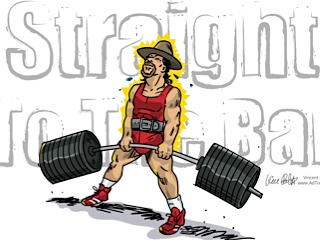
This month’s collaboration with Run to Win‘s Blaine Moore – Things which deserve more attention – continues with a look at one of my favourite pieces of training equipment, the kettlebell.
Although kettlebells have been around for an incredibly long time, they’ve only been readily available (in the US, at any rate) in the last decade or so. Without some serious leg-work, anyway.
As Mike noted recently, kettlebells can now be purchased at Target. If you’re considering rushing out and getting one, here are a few things that may help.
What are they?
One of the first descriptions I heard was ‘a cannonball with a handle‘. The design has hardly changed over the centuries, and neither should that description. That really is what they’re like.
Which size should I get?
As you’d expect, this varies according to your current strength and size. If possible, try out a friend’s kettlebell at the local gym (or wherever they work out). If not, here are a few guidelines that’ll steer you in the right direction.
From the article Buying your first kettlebell over at the Former Fat Guy Blog :
For guys, a good starting point is a 16 kg/36 lb bell. This was the first one I bought, and it’s more challenging than the weight would suggest. For anyone with a few years of weight training under their belt, or anyone over 183cm/6′ and about 90kg/198lb, consider starting with a 24 kg/54 lb bell. If you get a chance to try one out somewhere before you buy it, pick it up and clean it (lift it to your chest, don’t get out the polishing rag). That’ll give you a reasonable idea.
The female equivalents are about half these (on average – of course there are those who would easily work with more than this), 8 kg and 12 kg. Again, if you can try before you buy, great.
If you already have a kettlebell and are considering a second, typical progressions are 16/24/32 kg (for men) and 8/12/16 kg (for women). Once you have these three, if you want more, start again at 16 or 8. There are plenty of exercises involving two bells, and many of these are easier with the same weight for each.
NB : younger athletes may wish to consider halving the recommended weights for adults (depending on their age, size and strength).
Where do I get them?
As noted above, Target is now on the list. Other sources include :
- sporting goods retailers, both online and offline
- auctions, both online and offline (a second-hand kettlebell is virtually identical to a new one – they last for decades)
- martial arts suppliers, both online and offline
- fitness seminars and exhibitions
NB : they can be fairly heavy, so postage may be costly. Get one locally whenever possible.
What do you do with them?
There are many more kettlebell exercises possible than I realised when I bought my first one. These include the vast majority of dumbbell exercises, as well as a range of movements that make full use of the kettlebell’s unusual properties.
I’ve noted a number of resources below (many of them free); but if you’re itching to get going, master the Kettlebell Swing. This video demonstrates exactly how it’s done.
Staying informed
As with any form of strength-training, it’s great to keep up with changes in equipment and training approaches. These will get you started :
This site
Elsewhere
- Minute of Strength newsletter : excellent video demonstrations of kettlebell exercises.
- Mike Mahler’s Agressive Strength Magazine : always informative.
- Encyclopedia Of Kettlebell Lifting Series 1 : Steve Cotter at work. Need I say more? Make sure you also grab his newsletter.
- Enter The Kettlebell! : Pavel at his evil best.
- From Russia with Tough Love : a great read.
Final thoughts on kettlebell training
The next time you get a chance, try out a kettlebell. It’s a decision you’ll never regret.











0 Comments